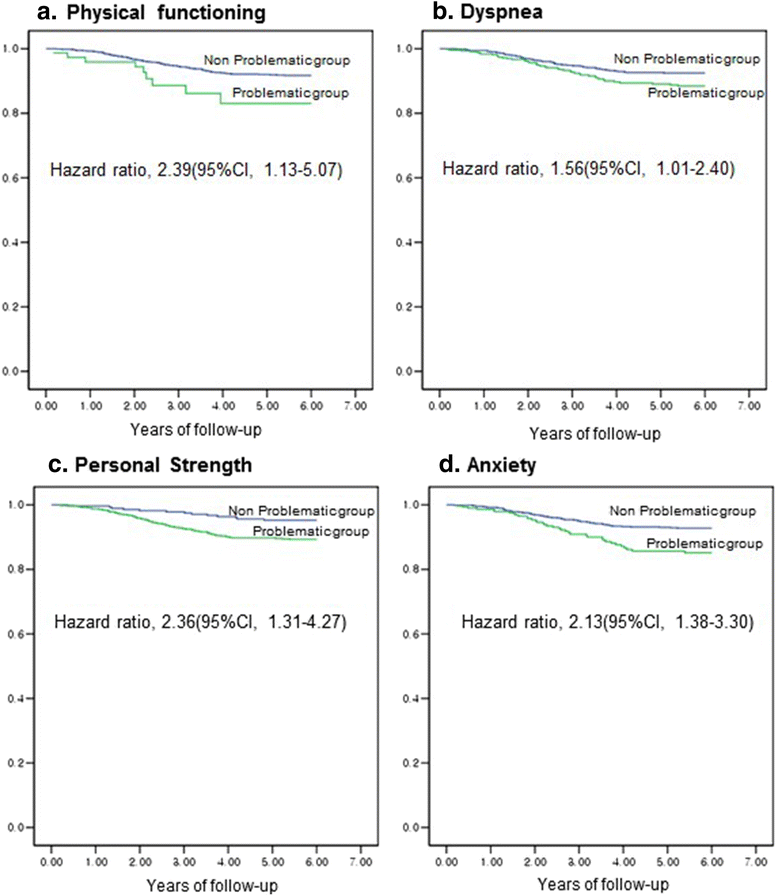Prognostic value of quality of life score in disease-free survivors of surgically-treated lung cancer
- PMID: 27439430
- PMCID: PMC4952058
- DOI: 10.1186/s12885-016-2504-x
Prognostic value of quality of life score in disease-free survivors of surgically-treated lung cancer
Abstract
Background: We aimed to evaluate the prognostic value of quality of life (QOL) for predicting survival among disease-free survivors of surgically-treated lung cancer after the completion of cancer treatment.
Methods: We administered the European Organization for Research and Treatment of Cancer Quality of Life Questionnaire Core 30 (EORTC QLQ-C30), the Quality of Life Questionnaire Lung Cancer Module (QLQ-LC13), Hospital Anxiety and Depression Scale (HADS), and Posttraumatic Growth Inventory (PTGI) to 809 survivors who were surgically-treated for lung cancer at two hospitals from 2001 through 2006. We gathered mortality data by linkage to the National Statistical Office through December 2011. We used Cox proportional hazard models to compute adjusted hazard ratios (aHRs) and 95 % confidence intervals (CIs) to estimate the relationship between QOL and survival.
Results: Analyses of QOL items adjusted for age, sex, stage, body mass index, and physical activity showed that scores for poor physical functioning, dyspnea, anorexia, diarrhea, cough, personal strength, anxiety, and depression were associated with poor survival. With adjustment for the independent indicators of survival, final multiple proportional hazard regression analyses of QOL show that physical functioning (aHR, 2.39; 95 % CI, 1.13-5.07), dyspnea (aHR, 1.56; 95 % CI, 1.01-2.40), personal strength (aHR, 2.36; 95 % CI, 1.31-4.27), and anxiety (aHR, 2.13; 95 % CI, 1.38-3.30) retained their independent prognostic power of survival.
Conclusion: This study suggests that patient-reported QOL outcomes in disease-free survivors of surgically-treated lung cancer after the completion of active treatment has independent prognostic value for long-term survival.
Figures

References
-
- Kim MK, Sim JA, Yun YH, Bae DS, Nam JH, Park CT, Cho CH, Lee JM, Park SY. Health-related quality of life and sociodemographic characteristics as prognostic indicators of long-term survival in disease-free cervical cancer survivors. Int J Gynecol Cancer. 2016. - PubMed
-
- Maione P, Perrone F, Gallo C, Manzione L, Piantedosi F, Barbera S, Cigolari S, Rosetti F, Piazza E, Robbiati SF, et al. Pretreatment quality of life and functional status assessment significantly predict survival of elderly patients with advanced non-small-cell lung cancer receiving chemotherapy: a prognostic analysis of the multicenter Italian lung cancer in the elderly study. J Clin Oncol. 2005;23(28):6865–72. doi: 10.1200/JCO.2005.02.527. - DOI - PubMed
MeSH terms
LinkOut - more resources
Full Text Sources
Other Literature Sources
Medical

